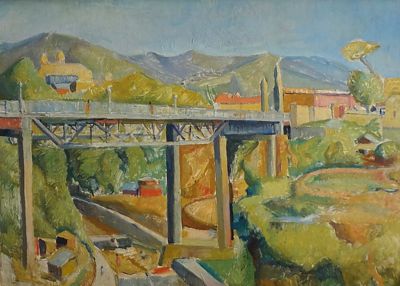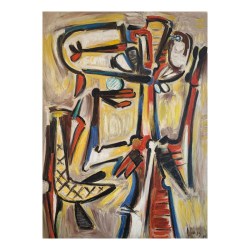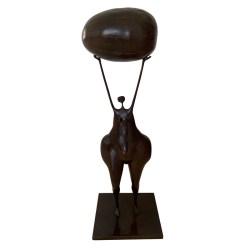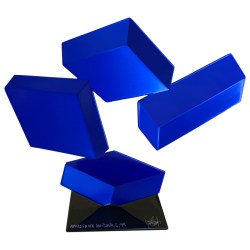Bio

Painter, son of Henry Navarro and Cruz Velasquez. In 1929 he studied in school Ollarves family of sisters and ends on 4 th grade at J. M. Echandia in 1933 and the following year is registered in the National Academy of Fine Arts in Caracas, who heads the sculptor Lorenzo Gonzalez. In 1939 Armando Reveron know who have great influence on his life and work. Navarro received a grant from the reformed Academy, now College of Fine Arts and Applied Arts (1940), then under the direction of Antonio Edmundo Monsanto. By 1941 his first works sent to the Second Annual Official Hall of Venezuelan Art, where he has created a special section for students of the School of Visual Arts and at the following Hall (1942) presents five paintings and two prints in the section students. Navarro received her first recognition in the V in 1944 for his work Creek, Trees and Sketch (the latter played in the National Review of Culture, 42).
In 1945, after completing his academic studies, along with living in Macuto Reveron, where he made a series of drawings and pastels and began his series of Nocturnes. That year was learned in the press a nervous breakdown suffered by the painter who was profiled by Guillermo Meneses in two papers (El Nacional, April 4 and April 18, 1945). From 1946 is his famous Girl with a Fan (gouache on paper, FGAN). "In his works sent to the official Salon of 1946 confirmed the presence of an exceptionally lucid painter, for whom the issue meant only the pretext to order the space. His painting dealt mainly color management as a basic structure beyond the shape to which, however, was subject "said Francisco Da Antonio ([1968], 1982, p. 265). In 1947 Matthew exposes Manaure at the Museum of Fine Arts his Girl with Fan, Federico Brandt received the Award and a scholarship to study in Paris, where he arrived in Manaure company on June 18. In 1948 he met the painter Hans Hartung who profoundly influence his work and sent first to the Salon de Mai and the following year sent to the First Exhibition of Latin American Artists in Paris, held at the Casa de America Latina. Receives Esteban Antonio Frias of Venezuela with his official Salon obraDesnudo and publishes a folder with 7 lithographs in an edition of 15 copies. Some of these pieces have a serial nature to explore Navarro later (as in Image Serial 1955 / Collection Paulina Villanueva). Barceló Cedeño Cruz commented that the influence of Hartung, Soulages and Schneider in the period 1948-1949 "is evident in the broad brushstrokes and agile with no degradation prior scheme of hues, in the expressive stroke, where they note, however, some discipline "(1994, p. 11). A representative work of this period is Figure Men (100 x 80 cm; Presidential Residence La Casona), signed in Paris in 1949. In 1950 he received the Second Prize at the National Arts Award for his role in the Venezuelan Official Salon with a figurative work, participate in the Salon d'Automne and along with Alejandro Otero and Matthew Manaure promotes the creation of the Dissidents, in whose magazine , is one of the main contributors. In 1951 he attended the Workshop Abstract Art Dewasne and Edgar Jean Pillet, breaks precepts of Dissidents (Alejandro Otero, 1993, p. 68-72) participating from this year until 1954 in the Salon Des Nouvelles Realités. At the time Navarro "sought harmony with a restricted range of colors and dynamic forms flat and regular and irregular contour, interspersed with each other and juxtaposing them to achieve effects and lively action" without exploring the field of the line itself ( Barceló Cedeño, op. cit., p. 7). In 1952, I included in the International Exhibition of Abstract Art (Four Walls Gallery, Caracas) and attends the May Salon in Paris. In 1953 three murals made abstract-geometric to the Plaza Deck, Concert Hall and Central Library of the University City of Caracas. That year, after collective exhibit at the Gallerie Denise Rene, Michel and Suzanne Cimaise, leaves the abstraction and return to figuration. In 1955 participates in the International Painting Exhibition in Valencia (Carabobo Edo.), with two works: Composition and Fall (1955, Collection Ateneo de Valencia), which marked a change of style, censored by Otero (1993, p. 94 - 95), and in 1957 by Michel Seuphor is included in the Dictionnaire de la peinture abstraite (Paris, Fernand Hazan). Between 1958 and 1961 experiences working with leading artistic orientation courses for students and workers in Spain and France. In 1963 he was appointed Artistic Director of Fina Gomez Foundation and in 1968, after a severe nervous breakdown in Madrid, he returned permanently to Venezuela, devoting himself to teaching drawing and painting at the Tower of the Press (1969-1976). Navarro was a prominent art critic, began his contributions to El Nacional, where he published the January 26, 1947 a brilliant article on Reveron under plastic precepts. Much of the work of this artist was done with gouache on paper, like the famous or Macuto Fan Girl (1946, Museo Arturo Michelena), where the artist left unpainted areas to take advantage of the color of the support, in the fifties made some free brushstrokes abstract works, as on Perpendicular Abstract Composition (1950, Museo Arturo Michelena), later used the oil on surfaces impeccably finished and delineated (Black, White and Yellow, 1952, Collection Paulina Villanueva). Alfredo Boulton on Navarro stated: "In every relationship is made of the painting in Venezuela during the 40 to 50, is essential to consider the early work of Pascual Navarro. Its production, limited in quantity, stood within their age group, by a strong personality [...] Within the first generation of students was possibly Navarro Mint one that felt and assimilated more deeply the call of the new trends. His ardor of character , its deep understanding, his sharpened and fine perception of the problems had made him one of our greatest hopes pictorial [...] When held Reveron Retrospective Exhibition at the Venezuelan Central American in 1943, Navarro then met two important canvases on themes nightly procession of the Virgin in the Valley and Patio with Luna. In these works was raised, with a tremendous force of suggestion, the mysterious meaning of the image Reverón always endeavored to transmit and had a of the clearest exponents in The Cave. not the first among the boys of the Mint to understand this attitude of Reveron was Navarro, who from that moment he became mesmerized by the work of the great artist. The very fine analytical concept that had allowed then run in 1945 a series of Nocturnes, which are the best proof of the high sensitivity of the spirit [...] In 1948, Navarro was living in Paris, where he became acquainted with a new cultural horizon and saw the message abstract-geometric of those who were at the forefront of that movement. fell under the influence of Dewasne, Herbin and Pillet and was among the most passionate advocates of this new modality. From his initial training kept figurative concepts and it was inevitable, he, too, Picasso show certain structures of the step by step, it was releasing more and more to achieve an expression in terms of character, the conception of the subject and message, which was itself fully. In subsequent years, Navarro undertook other roads, which departed from the practice of Fine Arts. He became a student of color theories, which would bring in other directions, which is why he left that year which had begun so hopefully "(1972, III, p. 154). The National Art Gallery Foundation (FGAN) Navarro has 3 cakes first stage: an undated self-portrait, a Girl, 1946 and 1948 and a Nude Self Portrait (1949) in gouache.EXHIBITIONS• 1946: Library La France, Caracas.• 1952: Arnaud Gallery, Paris.• 1956: Clan Gallery, Madrid.• 1968: Drawings and Pastels, XX2 Gallery, Caracas.• 1970: Faces of Women in the shadow of blossoming girls, BANAP Gallery, Caracas.• 1973: Exhibition Hall Plaza Bolivar, Caracas. Michelena Gallery, Caracas.• 1978: Andre Gallery, CaracasPosthumous Exhibitions• 1994: Pascual Navarro: Images and Perceptions of Time, Arturo Michelena Museum Foundation, Caracas.• 1998: From Neoclassical Gala, Museum of Contemporary Art of Zulia, Maracaibo, Edo. Zulia.AWARDS• 1944: Merit Award for Special Works, V Hall Official Annual Venezuelan Art, Museum of Fine Arts, Caracas.• 1946: Award Mujica Andres Perez, IV Arts Salon Arturo Michelena, Ateneo de Valencia, Edo. Carabobo.• 1947: Award Federico Brandt, VIII Annual Official Hall of Venezuelan Art, Museum of Fine Arts, Caracas.• 1949: Award Esteban Antonio Frias, X Official Salon Annual Venezuelan Art, Museum of Fine Arts, Caracas.• 1950: Second Prize for Painting, Room XI Official Annual Venezuelan Art, Museum of Fine Arts, Caracas.• 1953: Award Emilio Boggio, XI Arts Salon Arturo Michelena, Ateneo de Valencia, Edo. Carabobo.• 1955: Grand Prix for Venezuelan Painters, International Painting Exhibition, Ateneo de Valencia, Edo. Carabobo.• 1957: Second Prize, IX Planchart Hall, Caracas.• 1984: Prize Armando Reveron, Venezuelan Association of Plastic Artists (AVAP), CaracasCOLLECTIONS• Ateneo de Valencia, Edo. Carabobo.• National Art Gallery Foundation, Caracas, Mexico City.• Arturo Michelena Museum Foundation, Caracas, Mexico City.• Museum of Anzoategui, Barcelona, Edo. Anzoategui.• Museum of Modern Art in Merida, Edo. Mérida.• Museum of Fine Arts, Caracas, Mexico City.• Jesus Soto Museum, Ciudad Bolivar, Edo. Bolivar.• Presidential Residence La Casona, Caracas, Mexico City.• Central University of Venezuela, Caracas, Mexico City.AUDIOVISUAL DOCUMENTS CONCERNING THE ARTIST• Constructive Venezuelan Art, 1945-1965 Genesis and Development. Part I and II (VHS / color / sound / Spanish). Production: CONAC / National Art Gallery. Caracas, 1986. Location: CINAP / National Art Gallery.• The Venezuelan Constructive Art, 1945-1965 Genesis and Development. Art Series Part I, Journal Lagoven (Betacam / color / sound / Spanish / 50 min.). Address: Peter Manuel, Production: Cochano Films. Caracas, 1986. Location: Audiovisual Division - PDVSA.SOURCES• CINAP, FGAN, N 5• Barceló Cedeño Cruz, "Pascual Navarro from figuration to abstraction," in Pascual Navarro, images and perceptions of time (cat. exp.), Caracas, Fundación Museo Arturo Michelena, 1994.• Boulton, Alfredo, History of painting in Venezuela, III, Caracas, Ernesto Armitano Editor, 1972.• Da Antonio, Francisco, Texts on art (1682-1982 Venezuela), Caracas, Mount Avila, 1982.• Granados Valdes, A., Guide artworks of the University City of Caracas, Caracas, Commission of Conservation of Works of Art at the University City of Caracas, 1974.







